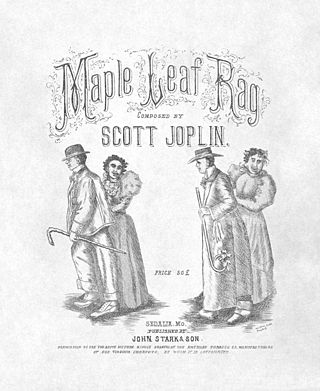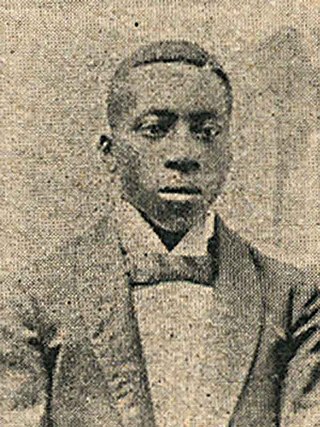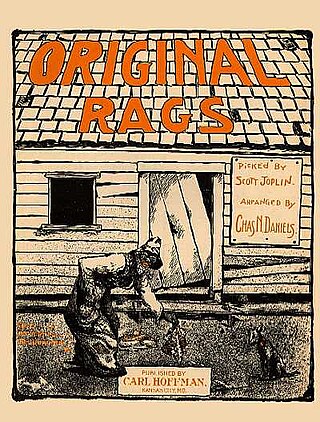Ragtime, also spelled rag-time or rag time, is a musical style that had its peak from the 1890s to 1910s. Its cardinal trait is its syncopated or "ragged" rhythm. Ragtime was popularized during the early 20th century by composers such as Scott Joplin, James Scott and Joseph Lamb. Ragtime pieces are typically composed for and performed on piano, though the genre has been adapted for a variety of instruments and styles.

Scott Joplin was an American composer and pianist. Dubbed the "King of Ragtime", he composed more than 40 ragtime pieces, one ragtime ballet, and two operas. One of his first and most popular pieces, the "Maple Leaf Rag", became the genre's first and most influential hit, later being recognized as the quintessential rag. Joplin considered ragtime to be a form of classical music meant to be played in concert halls and largely disdained the performance of ragtime as honky tonk music most common in saloons.

Joseph Francis Lamb was an American composer of ragtime music. Lamb, of Irish descent, was the only non-African American of the "Big Three" composers of classical ragtime, the other two being Scott Joplin and James Scott. The ragtime of Joseph Lamb ranges from standard popular fare to complex and highly engaging. His use of long phrases was influenced by classical works he had learned from his sister and others while growing up, but his sense of structure was potentially derived from his study of Joplin's piano rags. By the time he added some polish to his later works in the 1950s, Lamb had mastered the classic rag genre in a way that almost no other composer was able to approach at that time, and continued to play it passably as well, as evidenced by at least two separate recordings done in his home, as well as a few recorded interviews.

The "Maple Leaf Rag" is an early ragtime musical composition for piano composed by Scott Joplin. It was one of Joplin's early works, becoming the model for ragtime compositions by subsequent composers. It is one of the most famous of all ragtime pieces. Its success led to Joplin being dubbed the "King of Ragtime" by his contemporaries. The piece gave Joplin a steady if unspectacular income for the rest of his life.

Arthur Owen Marshall was an American composer and performer of ragtime music from Missouri. He was a protege of famed ragtime composer Scott Joplin.

Thomas Million John Turpin was an African American composer of ragtime music.

Charles Leslie Johnson was an American composer of ragtime and popular music. He was born in Kansas City, Kansas, died in Kansas City, Missouri, and lived his entire life in those two cities. He published over 300 songs in his life, nearly 40 of them ragtime compositions such as "Doc Brown’s Cakewalk", "Dill Pickles", "Apple Jack ", and "Snookums Rag". His best selling piece, a sentimental ballad called "Sweet and Low", sold over a million copies. Experts believe that had Johnson lived and worked in New York, he would be included alongside Scott Joplin, James Scott, and Joseph Lamb as one of the greatest ragtime composers. He wrote more than the other three combined and exemplified a greater range of talent, composing waltzes, tangos, cakewalks, marches, novelty pieces, and other types of music popular at that time.

Classic rag is the style of ragtime composition pioneered by Scott Joplin and the Missouri school of ragtime composers. These compositions were first considered "classic" by Joplin's publisher, John Stark, as a way to distinguish them from what he considered the "common" rags of other publishers. Today, any composition fitting this particular ragtime structural form is considered classic rag.

"The Entertainer" is a 1902 classic piano rag written by Scott Joplin.

"Magnetic Rag" is a 1914 ragtime piano composition by American composer Scott Joplin. It is significant for being the last rag which Joplin published in his lifetime, three years before his death in 1917. It is also unique in form and in some of the musical techniques employed in the composition.

"Original Rags" was an early ragtime medley for piano. It was the first of Scott Joplin's rags to appear in print, in early 1899, preceding his "Maple Leaf Rag" by half a year.

"Frog Legs Rag" is a classic rag composed by James Scott and published by John Stillwell Stark in December 1906. It was James Scott's first commercial success. Prior to this composition Scott had published marches. With "Frog Legs Rag", Scott embarked upon a career as a successful and important ragtime songwriter.

"Weeping Willow" is a 1903 classic piano ragtime composition by Scott Joplin. It was one of Joplin's simpler and less famous ragtime scores, written during a transitional period in his life, and one of the few pieces that Joplin cut as a piano roll in a 1916 session.

"Bethena, A Concert Waltz" is a composition by Scott Joplin. It was the first Joplin work since his wife Freddie's death on September 10, 1904, of pneumonia, ten weeks after their wedding. At the time the composer had significant financial problems; the work did not sell successfully at the time of publication and was soon neglected and forgotten. It was rediscovered as a result of the Joplin revival in the 1970s and has received acclaim from Joplin's biographers and other critics. The piece combines two different styles of music, the classical waltz and the rag, and has been seen as demonstrating Joplin's excellence as a classical composer. The work has been described as "an enchantingly beautiful piece that is among the greatest of Ragtime Waltzes", a "masterpiece", and "Joplin's finest waltz".

"The Easy Winners" is a ragtime composition by Scott Joplin. One of his most popular works, it was one of the four that had been recorded as of 1940.

"Sunflower Slow Drag" is a ragtime composition by Scott Joplin and Scott Hayden. It is about four minutes long and has been described as "full of gaiety and sunshine".

"The Ragtime Dance" is a piece of ragtime music by Scott Joplin, first published in 1902.
"The Silver Swan" by Scott Joplin is a ragtime composition for piano. It is the only known Joplin composition to be originally released on piano roll instead of in musical notation.

"Elite Syncopations" is a 1902 ragtime piano composition by American composer Scott Joplin, originally published in 1903 by John Stark & Son. The cover of the original sheet music prominently features a well-dressed man and lady sitting on a treble staff, looking down upon a cherub clutching a cymbal in each hand, which reflects plainly the title of the piece. In 1974, the British Royal Ballet, under director Kenneth MacMillan, created the ballet Elite Syncopations based on tunes by Joplin and other composers of the era.

"Wall Street Rag" is a ragtime composition by Scott Joplin, first published in 1909. As indicated by the title, the theme is based on Wall Street following the events surrounding the Panic of 1907. This is represented in the musical structure along with its corresponding annotations.


















